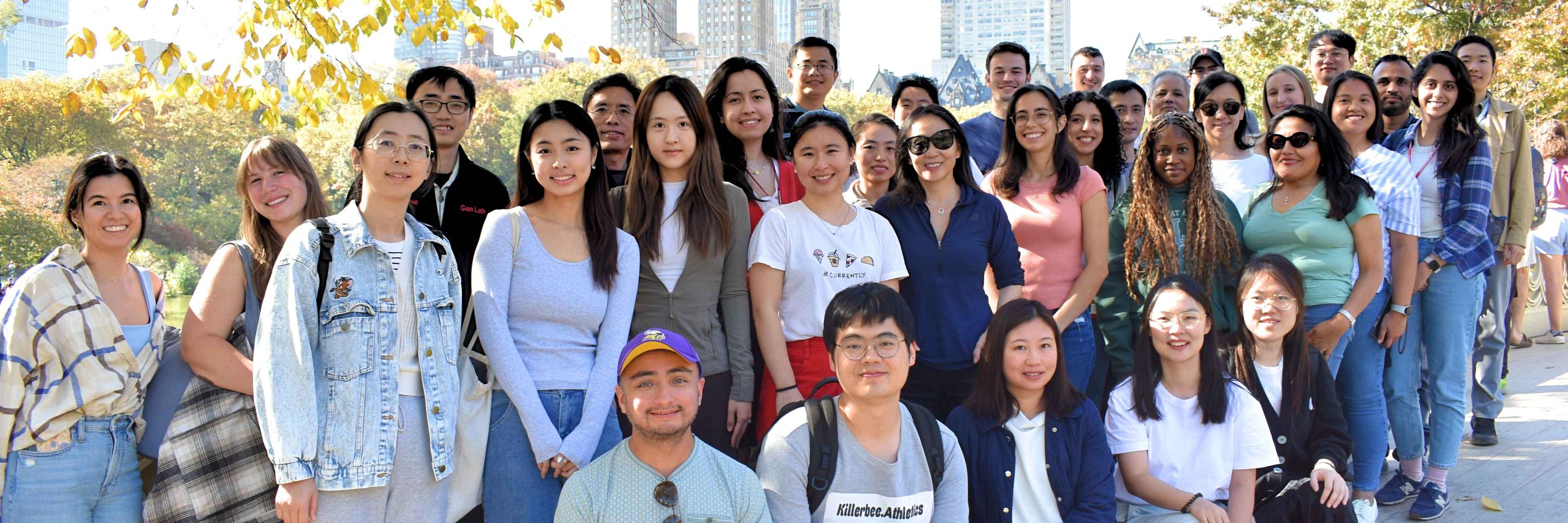
Gan Lab
@liganlab.bsky.social
Group of passionate scientists unraveling the mysteries of neurodegeneration at Weill Cornell Medicine 🧠 | Tackling Alzheimer’s, FTD, PD & related diseases 🧬 | Focused on tau, innate immunity, & targeted therapeutics using iPSC & transcriptomics🔬
Pinned
Gan Lab
@liganlab.bsky.social
· Jun 24
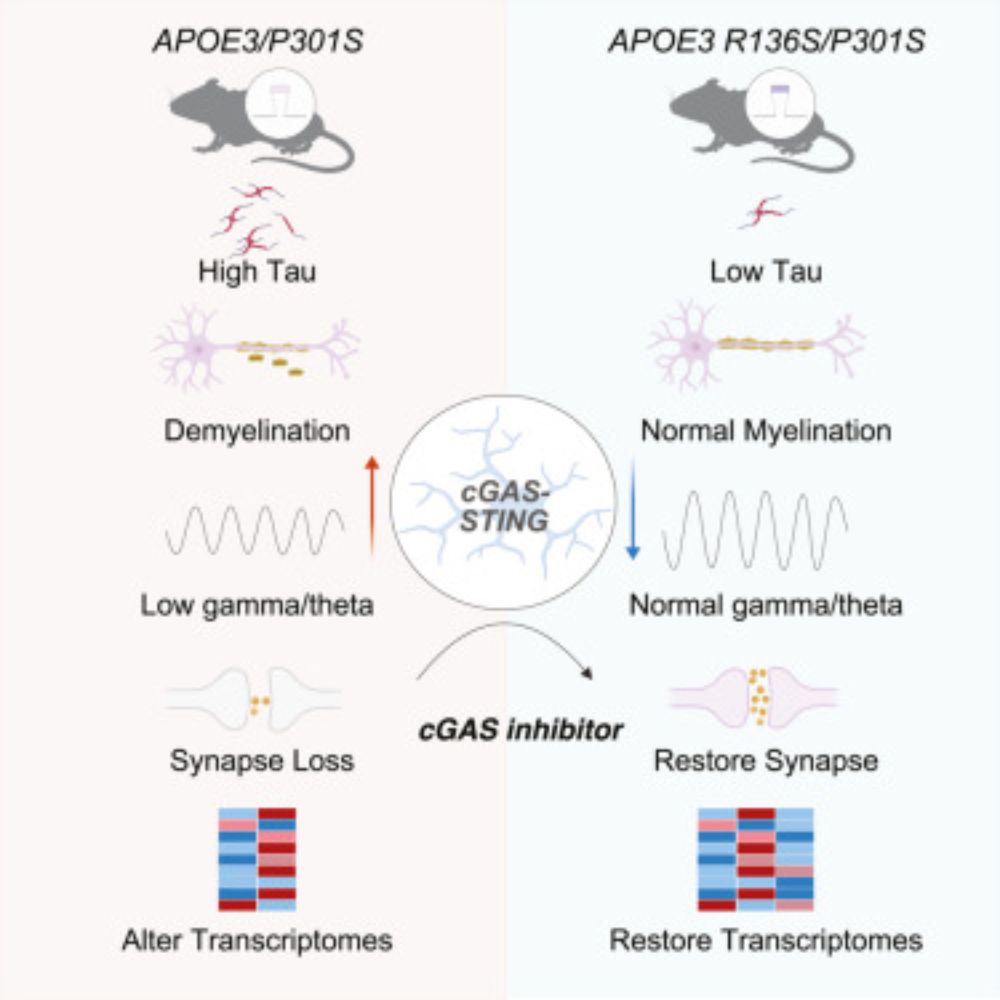
The R136S mutation in the APOE3 gene confers resilience against tau pathology via inhibition of the cGAS-STING-IFN pathway
The Christchurch mutation (R136S) in the APOE3 (E3S/S) gene is associated with attenuated tau load and cognitive decline despite the presence of a cau…
www.sciencedirect.com
🚨Our new paper is out!🚨 We uncover a protective mechanism of the rare APOE3 Christchurch (R136S) mutation against tauopathy—by suppressing microglial cGAS–STING–interferon (IFN) pathway, a key inflammatory axis triggered by tau. www.sciencedirect.com/science/arti...
Reposted by Gan Lab
Thrilled to publish our new study on #mitochondrial ROS coming from complex III, revealing this key site in #astrocytes 🎯as a crucial immunometabolic signal transducer🤯 and potential therapeutic target for #dementia #FTD 💊 rdcu.be/eOc0m 👈💪 Great commentary by H. Pan and F. Yin🤩! tinyurl.com/4hdytw4c

November 4, 2025 at 6:30 PM
Thrilled to publish our new study on #mitochondrial ROS coming from complex III, revealing this key site in #astrocytes 🎯as a crucial immunometabolic signal transducer🤯 and potential therapeutic target for #dementia #FTD 💊 rdcu.be/eOc0m 👈💪 Great commentary by H. Pan and F. Yin🤩! tinyurl.com/4hdytw4c
Two separate studies from Gitler & Fratta labs reveal nuclear loss of TDP-43 disrupts RNA processing by altering alternative 3′ end cleavage & polyadenylation. They uncover new molecular signatures & shed new light on TDP-43 pathology
www.nature.com/articles/s41...
www.nature.com/articles/s41...
www.nature.com/articles/s41...
www.nature.com/articles/s41...

TDP-43 loss induces cryptic polyadenylation in ALS/FTD - Nature Neuroscience
The authors find that TDP-43 loss of function—the pathology defining the neurodegenerative conditions ALS and FTD—induces novel mRNA polyadenylation events, which have different effects, including an ...
www.nature.com
October 31, 2025 at 6:22 PM
Two separate studies from Gitler & Fratta labs reveal nuclear loss of TDP-43 disrupts RNA processing by altering alternative 3′ end cleavage & polyadenylation. They uncover new molecular signatures & shed new light on TDP-43 pathology
www.nature.com/articles/s41...
www.nature.com/articles/s41...
www.nature.com/articles/s41...
www.nature.com/articles/s41...
Reposted by Gan Lab
New article @natneuro.nature.com by @yaleneuro.bsky.social Suzhou Yang & @kavliatyale.bsky.social Postdoc Fellow @zhenlei.bsky.social, highlighting studies by @frattalab.bsky.social Gitler & La Spada labs on the role of TDP-43 on mRNA 3' end in ALS @yalerna.bsky.social www.nature.com/articles/s41...

TDP-43 loss brings RNA to a twist ending - Nature Neuroscience
In amyotrophic lateral sclerosis (ALS), nuclear depletion and cytoplasmic aggregation of the RNA-binding protein TDP-43 cause widespread dysregulation of mRNA splicing. Two recent studies have now rev...
www.nature.com
October 21, 2025 at 12:16 PM
New article @natneuro.nature.com by @yaleneuro.bsky.social Suzhou Yang & @kavliatyale.bsky.social Postdoc Fellow @zhenlei.bsky.social, highlighting studies by @frattalab.bsky.social Gitler & La Spada labs on the role of TDP-43 on mRNA 3' end in ALS @yalerna.bsky.social www.nature.com/articles/s41...
Fascinating study from the Mao & Jiang lab: four amino acid residues unique to naked mole-rat cGAS, but absent in humans, are critical for efficient DNA repair, delaying aging and expanding life span. www.science.org/doi/epdf/10....

A cGAS-mediated mechanism in naked mole-rats potentiates DNA repair and delays aging
Efficient DNA repair might make possible the longevity of naked mole-rats. However, whether they have distinctive mechanisms to optimize functions of DNA repair suppressors is unclear. We find that na...
www.science.org
October 16, 2025 at 11:50 PM
Fascinating study from the Mao & Jiang lab: four amino acid residues unique to naked mole-rat cGAS, but absent in humans, are critical for efficient DNA repair, delaying aging and expanding life span. www.science.org/doi/epdf/10....
Mao, Han & Dawson labs reveal air pollutant PM2.5 triggers αSyn misfolding, forming a pathogenic strain (PM-PFF) that drives Lewy body dementia. This study illuminates the link between air pollution & neurodegenerative disease, offering insights for public health
www.science.org/doi/10.1126/...
www.science.org/doi/10.1126/...

Lewy body dementia promotion by air pollutants
Evidence links air pollution to dementia, yet its role in Lewy body dementia (LBD) remains unclear. In this work, we showed in a cohort of 56.5 million individuals across the United States that fine p...
www.science.org
October 10, 2025 at 8:26 PM
Mao, Han & Dawson labs reveal air pollutant PM2.5 triggers αSyn misfolding, forming a pathogenic strain (PM-PFF) that drives Lewy body dementia. This study illuminates the link between air pollution & neurodegenerative disease, offering insights for public health
www.science.org/doi/10.1126/...
www.science.org/doi/10.1126/...
Collaborative work from Zhang, Cai & Peng labs identifies a glia-neuron protein co-expression subnetwork as a central driver of AD from multiscale genetic and proteomic analyses. AHNAK emerges as a key astrocytic driver whose downregulation reduces pTau & Aβ levels. www.cell.com/cell/fulltex...

Multiscale proteomic modeling reveals protein networks driving Alzheimer’s disease pathogenesis
Multiscale proteomic network modeling of Alzheimer's disease integrates large-scale
proteomic and genetic data from vulnerable brain regions and reveals key driver proteins
such as AHNAK within a glia...
www.cell.com
October 3, 2025 at 9:09 PM
Collaborative work from Zhang, Cai & Peng labs identifies a glia-neuron protein co-expression subnetwork as a central driver of AD from multiscale genetic and proteomic analyses. AHNAK emerges as a key astrocytic driver whose downregulation reduces pTau & Aβ levels. www.cell.com/cell/fulltex...
Wu lab discovers early neuronal hyperactivity in TDP-43 induces rod-shaped microglia, which attenuates cortical hyperactivity, suggesting a neuroprotective role. Coincidentally, TREM2 signaling also promotes rod-shaped MG & neuroprotection. www.cell.com/immunity/abs...

Rod-shaped microglia interact with neuronal dendrites to attenuate cortical excitability during TDP-43-related neurodegeneration
While microglial activation is a hallmark in neurodegeneration, the specific role
of microglia in disease-related cortical excitability remains unknown. Xie et al.
reveal that rod-shaped microglia for...
www.cell.com
September 22, 2025 at 7:53 PM
Wu lab discovers early neuronal hyperactivity in TDP-43 induces rod-shaped microglia, which attenuates cortical hyperactivity, suggesting a neuroprotective role. Coincidentally, TREM2 signaling also promotes rod-shaped MG & neuroprotection. www.cell.com/immunity/abs...
New study from Yu & Sun identifies TFEB as a molecular link between neurons & oligodendrocytes (OL) in myelination. Neuronal signals trap TFEB in OL's cytoplasm, keeping TFEB from entering nucleus & repressing cholesterol biosynthesis genes, which causes hypomyelination
www.cell.com/cell-reports...
www.cell.com/cell-reports...

Neurons sequester the cholesterol-inhibiting TFEB in oligodendrocyte cytoplasm to safeguard myelination and neural function
Zhang et al. identify TFEB as a molecular link that connects extrinsic neuronal cues
to intrinsic oligodendrocyte transcriptional programs. TFEB directly binds to and
represses numerous cholesterol bi...
www.cell.com
September 11, 2025 at 10:41 PM
New study from Yu & Sun identifies TFEB as a molecular link between neurons & oligodendrocytes (OL) in myelination. Neuronal signals trap TFEB in OL's cytoplasm, keeping TFEB from entering nucleus & repressing cholesterol biosynthesis genes, which causes hypomyelination
www.cell.com/cell-reports...
www.cell.com/cell-reports...
Interesting study from Xu, Zhang & Mo labs: oxidized mtDNA can transform into Z-DNA & activate ZBP1–RIPK1–dependent inflammation in AD microglia. This highlights ZBP1–RIPK1 as a key regulatory axis of neuroinflammation & offers novel insights on AD inflammatory networks www.cell.com/immunity/ful...

Innate immune sensing of Z-nucleic acids by ZBP1-RIPK1 axis drives neuroinflammation in Alzheimer’s disease
Microglia-mediated neuroinflammation drives Alzheimer's disease (AD) pathogenesis,
yet the underlying mechanism is poorly understood. Song et al. demonstrate that toxic
amyloid-β induces oxidation and...
www.cell.com
September 6, 2025 at 9:51 PM
Interesting study from Xu, Zhang & Mo labs: oxidized mtDNA can transform into Z-DNA & activate ZBP1–RIPK1–dependent inflammation in AD microglia. This highlights ZBP1–RIPK1 as a key regulatory axis of neuroinflammation & offers novel insights on AD inflammatory networks www.cell.com/immunity/ful...
Reposted by Gan Lab
🏆🏆🏆 CONGRATULATIONS to the winner of the PBL Assay Science Best Speaker Award Sarah Naguib @sarahnaguib.bsky.social
Title: Elucidating the neuroprotective mechanisms of human microglial replacement therapy in FTD and PD
Thank you PBL Assay Science for sponsoring the award
Title: Elucidating the neuroprotective mechanisms of human microglial replacement therapy in FTD and PD
Thank you PBL Assay Science for sponsoring the award

August 26, 2025 at 6:02 PM
🏆🏆🏆 CONGRATULATIONS to the winner of the PBL Assay Science Best Speaker Award Sarah Naguib @sarahnaguib.bsky.social
Title: Elucidating the neuroprotective mechanisms of human microglial replacement therapy in FTD and PD
Thank you PBL Assay Science for sponsoring the award
Title: Elucidating the neuroprotective mechanisms of human microglial replacement therapy in FTD and PD
Thank you PBL Assay Science for sponsoring the award
The Kolachama Lab is tackling the PET scan bottleneck in Alzheimer’s diagnosis with an AI model that predicts amyloid-β & tau status from 12,185 patients across 7 cohorts, offering a scalable alternative for pre-screening & guiding PET imaging. www.nature.com/articles/s41...
AI-driven fusion of multimodal data for Alzheimer’s disease biomarker assessment - Nature Communications
A flexible AI framework integrates multimodal neurology work-up data to estimate amyloid and tau burden, supporting scalable biomarker stratification for Alzheimer’s disease research and trial screeni...
www.nature.com
August 25, 2025 at 5:42 PM
The Kolachama Lab is tackling the PET scan bottleneck in Alzheimer’s diagnosis with an AI model that predicts amyloid-β & tau status from 12,185 patients across 7 cohorts, offering a scalable alternative for pre-screening & guiding PET imaging. www.nature.com/articles/s41...
Exciting finding: Endogenous lithium is essential for brain health and its deficiency contributes to the onset and progression of Alzheimer’s disease, by activating GSK3β—leading to impaired Aβ clearance and synapse loss
🧠 Led by Dr. Bruce Yankner @harvardmed.bsky.social
🔗 doi.org/10.1038/s415...
🧠 Led by Dr. Bruce Yankner @harvardmed.bsky.social
🔗 doi.org/10.1038/s415...

Lithium deficiency and the onset of Alzheimer’s disease - Nature
Lithium has an essential role in the brain and is deficient early in Alzheimer’s disease, which can be recapitulated in mice and treated with a novel lithium salt that restores the physiological level...
doi.org
August 8, 2025 at 6:53 PM
Exciting finding: Endogenous lithium is essential for brain health and its deficiency contributes to the onset and progression of Alzheimer’s disease, by activating GSK3β—leading to impaired Aβ clearance and synapse loss
🧠 Led by Dr. Bruce Yankner @harvardmed.bsky.social
🔗 doi.org/10.1038/s415...
🧠 Led by Dr. Bruce Yankner @harvardmed.bsky.social
🔗 doi.org/10.1038/s415...
By developing an antibody-based method using mass spec, this study uncovered >200 UFMylation sites across mouse tissues—including on myosin. Myosin UFMylation is elevated in skeletal muscle from people with ALS, suggesting in vivo UFMylation is more dynamic than expected www.cell.com/cell-reports...

Site-specific quantification of the in vivo UFMylome reveals myosin modification in ALS
UFMylation is the post-translational modification of Ubiquitin Fold Modifier1 (UFM1)
applied to substrate proteins. Blazev et al. develop an antibody-based enrichment
approach followed by LC-MS/MS to ...
www.cell.com
August 6, 2025 at 8:04 PM
By developing an antibody-based method using mass spec, this study uncovered >200 UFMylation sites across mouse tissues—including on myosin. Myosin UFMylation is elevated in skeletal muscle from people with ALS, suggesting in vivo UFMylation is more dynamic than expected www.cell.com/cell-reports...
Fascinating study from Hyman, Alberti & Mittal labs reveals how stress granules promote TDP-43 aggregation through intra-condensate demixing driven by Cys oxidation & hydrophobic patch contacts, marking the crucial role of stress granules & opening new doors for therapy.
www.cell.com/cell/fulltex...
www.cell.com/cell/fulltex...

Intra-condensate demixing of TDP-43 inside stress granules generates pathological aggregates
Stress granules promote TDP-43 aggregation via intra-condensate demixing, a pathway
triggered by its up-concentration and oxidation within condensates. Blocking this
demixing pathway prevents TDP-43 a...
www.cell.com
August 5, 2025 at 2:50 PM
Fascinating study from Hyman, Alberti & Mittal labs reveals how stress granules promote TDP-43 aggregation through intra-condensate demixing driven by Cys oxidation & hydrophobic patch contacts, marking the crucial role of stress granules & opening new doors for therapy.
www.cell.com/cell/fulltex...
www.cell.com/cell/fulltex...
The Sirota & Huang labs identified a novel letrozole–irinotecan combination therapy that improves memory and reduces pathology in Alzheimer's disease models—showcasing a transformative drug discovery approach rooted in human transcriptomics and real-world clinical data www.cell.com/cell/fulltex...
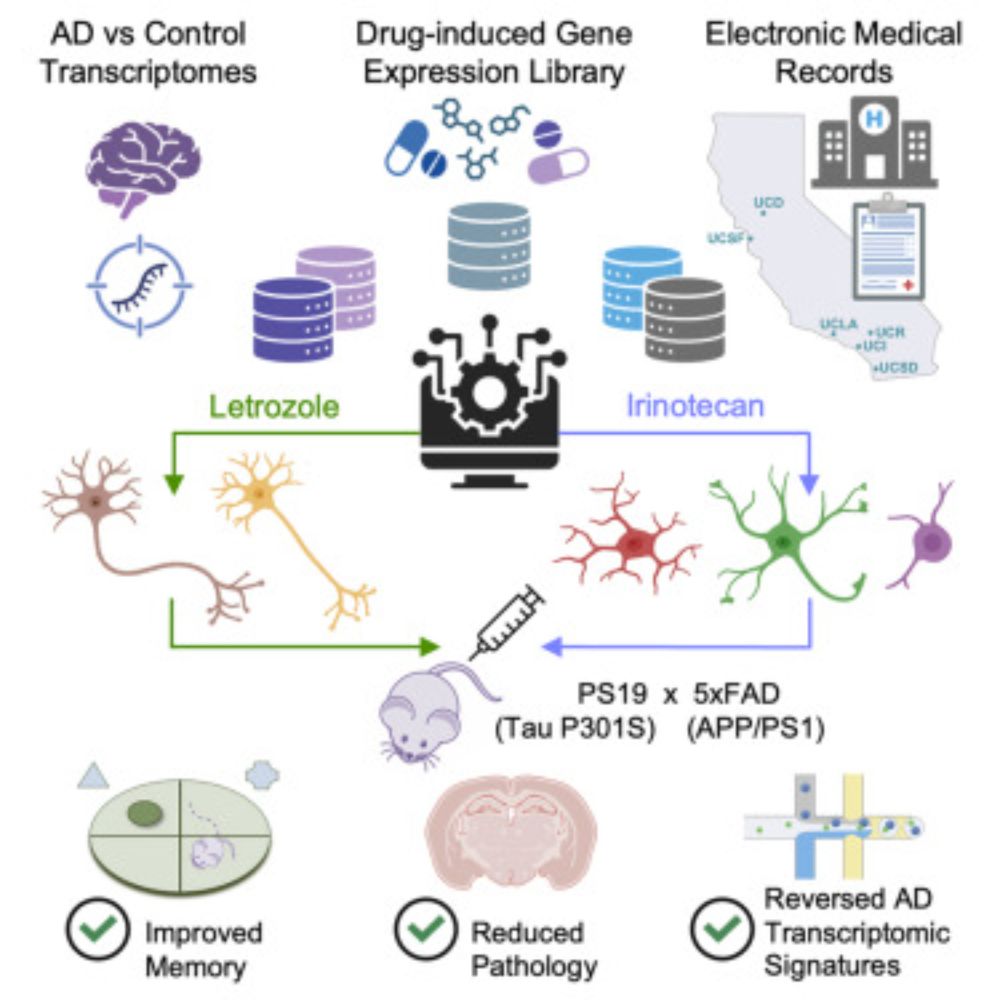
Cell-type-directed network-correcting combination therapy for Alzheimer’s disease
A multi-cell-type drug discovery strategy targeting dysregulated gene networks in
neurons and glia identified letrozole and irinotecan as a combination therapy that
significantly improved memory and r...
www.cell.com
July 28, 2025 at 9:32 PM
The Sirota & Huang labs identified a novel letrozole–irinotecan combination therapy that improves memory and reduces pathology in Alzheimer's disease models—showcasing a transformative drug discovery approach rooted in human transcriptomics and real-world clinical data www.cell.com/cell/fulltex...
New from Tilgner & Gan labs: Using ScISOr–ATAC, we found that splicing patterns differ across cell states within the same cell type in frozen primate cortex, and that oligodendrocytes in Alzheimer’s show high dysregulation in splicing & chromatin. Read more: www.nature.com/articles/s41...
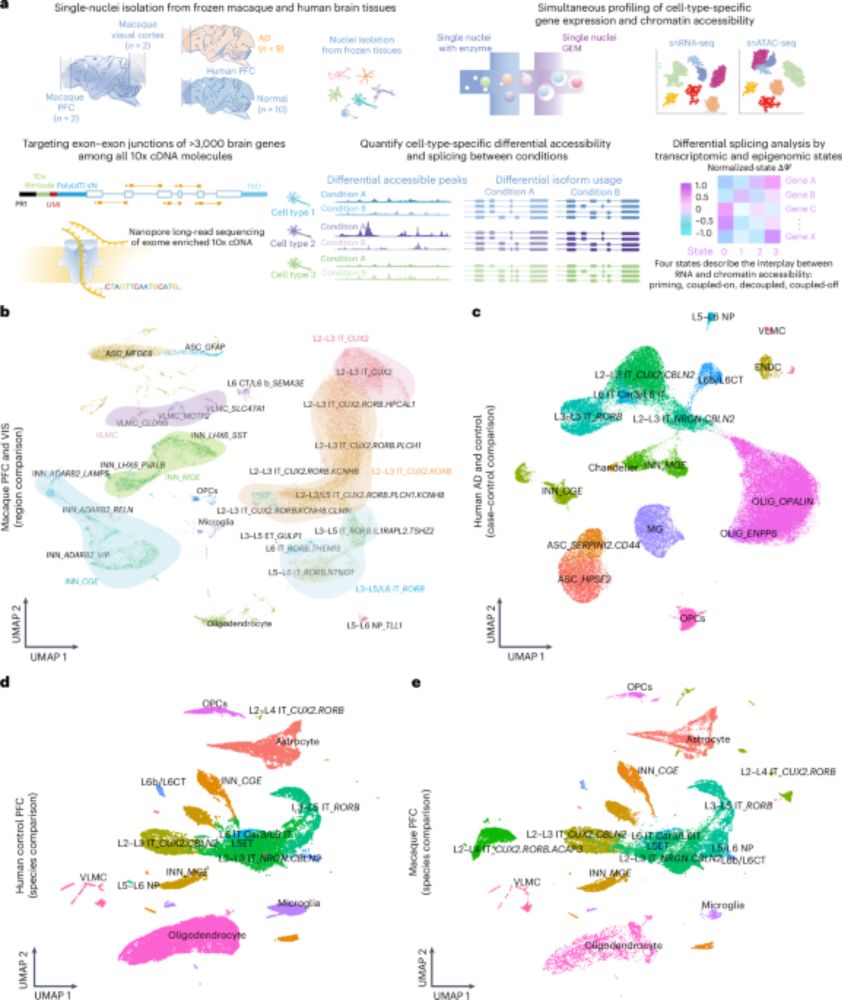
Combined single-cell profiling of chromatin–transcriptome and splicing across brain cell types, regions and disease state - Nature Biotechnology
Joint profiling of chromatin and splicing in the brain uncovers shared and distinct patterns.
www.nature.com
July 23, 2025 at 4:26 PM
New from Tilgner & Gan labs: Using ScISOr–ATAC, we found that splicing patterns differ across cell states within the same cell type in frozen primate cortex, and that oligodendrocytes in Alzheimer’s show high dysregulation in splicing & chromatin. Read more: www.nature.com/articles/s41...
🚨Our new paper is out!🚨 We uncover a protective mechanism of the rare APOE3 Christchurch (R136S) mutation against tauopathy—by suppressing microglial cGAS–STING–interferon (IFN) pathway, a key inflammatory axis triggered by tau. www.sciencedirect.com/science/arti...

The R136S mutation in the APOE3 gene confers resilience against tau pathology via inhibition of the cGAS-STING-IFN pathway
The Christchurch mutation (R136S) in the APOE3 (E3S/S) gene is associated with attenuated tau load and cognitive decline despite the presence of a cau…
www.sciencedirect.com
June 24, 2025 at 12:58 PM
🚨Our new paper is out!🚨 We uncover a protective mechanism of the rare APOE3 Christchurch (R136S) mutation against tauopathy—by suppressing microglial cGAS–STING–interferon (IFN) pathway, a key inflammatory axis triggered by tau. www.sciencedirect.com/science/arti...
Our 12th Annual Appel Symposium was a huge success! Record attendance, insightful faculty speakers, and a vibrant poster session sparked meaningful conversations and highlighted the innovative research at WCM. A sincere thank you to all who attended and the WCM teams who made this event possible.


May 23, 2025 at 9:49 PM
Our 12th Annual Appel Symposium was a huge success! Record attendance, insightful faculty speakers, and a vibrant poster session sparked meaningful conversations and highlighted the innovative research at WCM. A sincere thank you to all who attended and the WCM teams who made this event possible.
Congratulations, Akida Abulimit @akidaabu.bsky.social, for winning 3rd place in Poster Presentation at the Weill Cornell Graduate Program in Physiology, Biophysics and Systems Biology 2024 Retreat!

May 13, 2025 at 8:53 PM
Congratulations, Akida Abulimit @akidaabu.bsky.social, for winning 3rd place in Poster Presentation at the Weill Cornell Graduate Program in Physiology, Biophysics and Systems Biology 2024 Retreat!
Our lab enjoyed the exciting scientific advancements & fruitful discussions at the NYAS Therapeutic Approaches to Protein Misfolding in Neurodegenerative Disease conference this week! Dr. Gan presented on enhancing resilience against tau alongside other stellar speakers. www.nyas.org/shaping-scie...
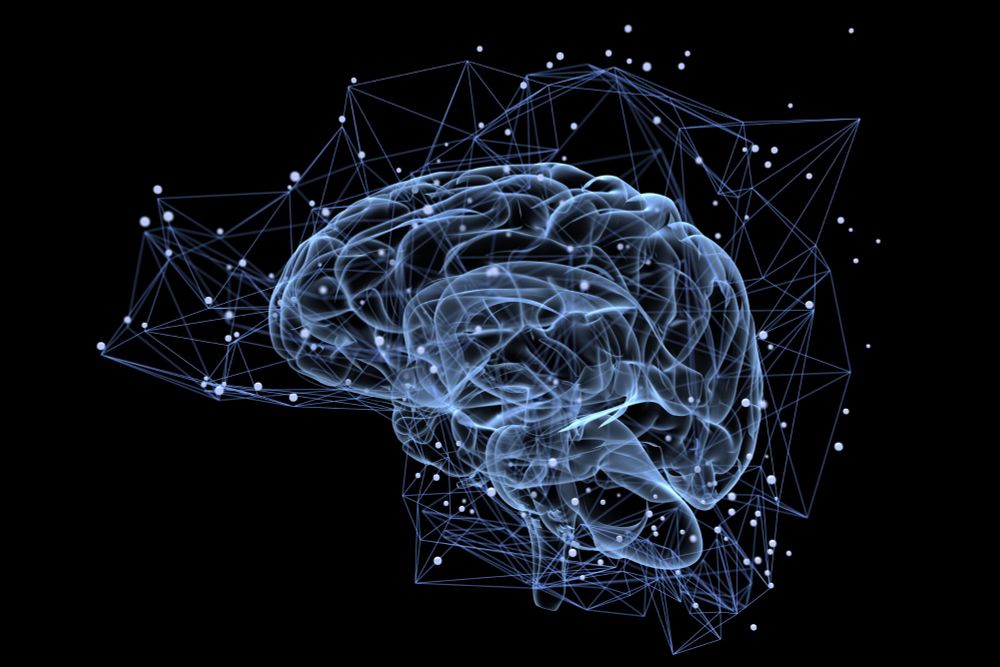
Events - NYAS
Bringing together experts and partners from academia, industry, and government, the Academy convenes conferences, symposia, and workshops that provide a neutral forum for the exchange of information o...
www.nyas.org
April 30, 2025 at 9:53 PM
Our lab enjoyed the exciting scientific advancements & fruitful discussions at the NYAS Therapeutic Approaches to Protein Misfolding in Neurodegenerative Disease conference this week! Dr. Gan presented on enhancing resilience against tau alongside other stellar speakers. www.nyas.org/shaping-scie...
Exciting work @blurtonjoneslab.bsky.social: CRISPR-engineered iPSC-microglia use the plaque-responsive CD9 promoter to deliver Aβ-degrading neprilysin across the brain-- reducing plaques, inflammation & synaptic loss. A promising new cell therapy platform for AD www.sciencedirect.com/science/arti...
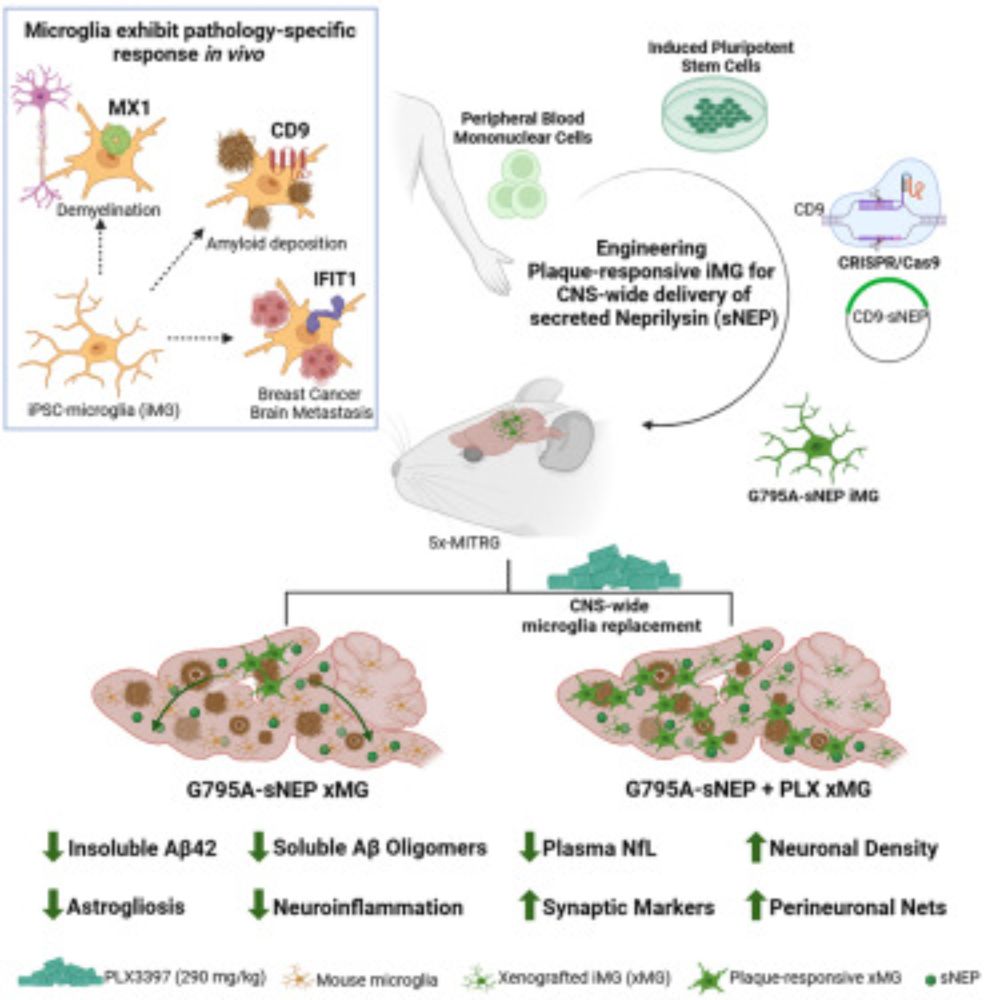
Harnessing human iPSC-microglia for CNS-wide delivery of disease-modifying proteins
Widespread delivery of therapeutic proteins to the brain remains challenging. To determine whether human induced pluripotent stem cell (iPSC)-microgli…
www.sciencedirect.com
April 25, 2025 at 6:23 PM
Exciting work @blurtonjoneslab.bsky.social: CRISPR-engineered iPSC-microglia use the plaque-responsive CD9 promoter to deliver Aβ-degrading neprilysin across the brain-- reducing plaques, inflammation & synaptic loss. A promising new cell therapy platform for AD www.sciencedirect.com/science/arti...
Reposted by Gan Lab
According to researchers Kanta Horie, Gemma Salvadó, Rama Koppisetti, Oskar Hansson, Randall Bateman, et al. newly developed blood test for #Alzheimers not only aids in diagnosis of Alzheimer's but also indicates how far it has progressed. Learn More in Nature Medicine
www.nature.com/articles/s41...
www.nature.com/articles/s41...

Plasma MTBR-tau243 biomarker identifies tau tangle pathology in Alzheimer’s disease - Nature Medicine
Plasma eMTBR-tau243 is a specific biomarker of tau tangles in Alzheimer’s disease and enables the detecting and tracking of Alzheimer’s clinical impairment.
www.nature.com
April 4, 2025 at 6:52 PM
According to researchers Kanta Horie, Gemma Salvadó, Rama Koppisetti, Oskar Hansson, Randall Bateman, et al. newly developed blood test for #Alzheimers not only aids in diagnosis of Alzheimer's but also indicates how far it has progressed. Learn More in Nature Medicine
www.nature.com/articles/s41...
www.nature.com/articles/s41...
Fascinating study from Nature reveals crosstalk between mitochondrial translation, ROS activity, and the membrane retromer complex. www.nature.com/articles/s41...

Oxidation of retromer complex controls mitochondrial translation - Nature
Systematic base-editing and computational screens identify specific cysteine residues on VPS35 in the retromer complex as key sensors that decrease mitochondrial translation in response to reactive ox...
www.nature.com
April 4, 2025 at 5:26 PM
Fascinating study from Nature reveals crosstalk between mitochondrial translation, ROS activity, and the membrane retromer complex. www.nature.com/articles/s41...
A CSF proteomics study in Nature Medicine of 3,397 individuals identified synaptic proteins YWHAG:NPTX2 as key correlates of cognitive impairment in AD, highlighting synapse dysfunction as a core driver of AD dementia. #Alzheimers #Proteomics #Neurodegeneration www.nature.com/articles/s41...

A cerebrospinal fluid synaptic protein biomarker for prediction of cognitive resilience versus decline in Alzheimer’s disease - Nature Medicine
The ratio between the levels of two synaptic proteins in cerebrospinal fluid predicts future cognitive resilience versus decline among presymptomatic individuals and individuals with early Alzheimer’s...
www.nature.com
April 4, 2025 at 4:23 PM
A CSF proteomics study in Nature Medicine of 3,397 individuals identified synaptic proteins YWHAG:NPTX2 as key correlates of cognitive impairment in AD, highlighting synapse dysfunction as a core driver of AD dementia. #Alzheimers #Proteomics #Neurodegeneration www.nature.com/articles/s41...
Big congratulations to Dr. Celeste Parra Bravo! 🎓 Last Tues, 3/25, Dr. Parra Bravo defended her thesis with command and grace. Next, she’s headed to a postdoc in the Rosato lab at Dartmouth. We’re so proud of all she’s accomplished and can’t wait to see her continued contributions to science!🧪🔬🧠

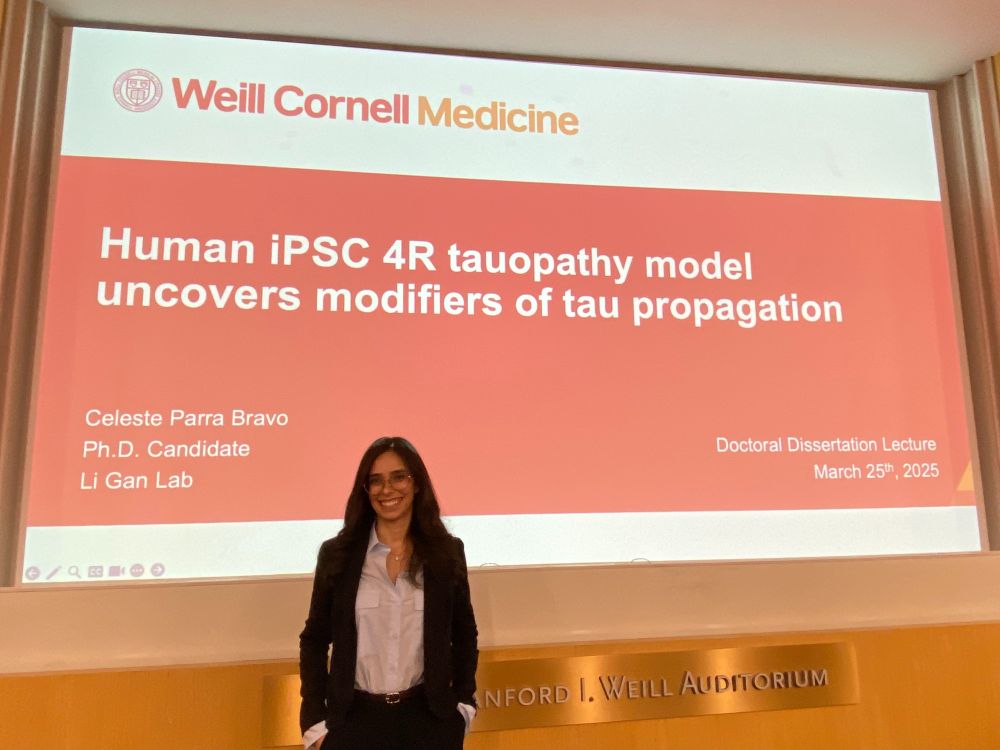
April 1, 2025 at 4:59 PM
Big congratulations to Dr. Celeste Parra Bravo! 🎓 Last Tues, 3/25, Dr. Parra Bravo defended her thesis with command and grace. Next, she’s headed to a postdoc in the Rosato lab at Dartmouth. We’re so proud of all she’s accomplished and can’t wait to see her continued contributions to science!🧪🔬🧠

